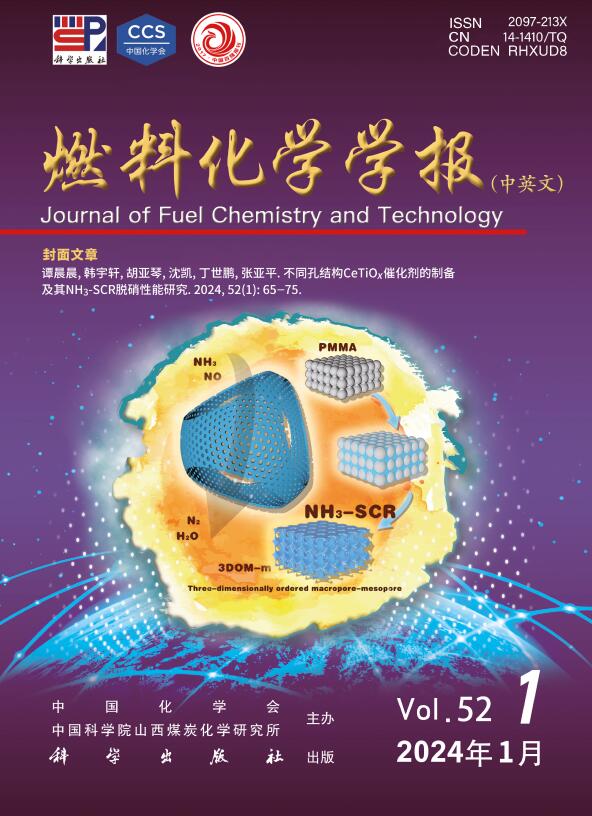蜂窝陶瓷氧化铝负载Fe-Cr复合催化剂在CO选择性催化还原烟气脱氧中的性能
Q3 Energy
引用次数: 0
摘要
利用CO对NOx进行选择性催化还原(CO- scr),可以显著降低锅炉烟气处理的脱硝成本。本文研究了蜂窝陶瓷氧化铝负载Fe-Cr复合材料(Fe-Cr/HCA)在CO-SCR烟气脱硝中的高温催化性能,并对催化剂制备参数如双金属比、老化温度、金属负载量等进行了优化。结果表明:Fe-Cr/HCA催化剂表面形成了fer2o4固溶体,Fe2O3与Cr2O3的协同作用大大提高了CO-SCR脱硝效率;其中,Fe/Cr比为1、老化温度为300℃、浸渍15次的Fe-Cr/HCA催化剂在NO的CO-SCR中表现出优异的性能,在400-800℃的测试条件下NO转化率接近100%。此外,六次浸渍的催化剂可用于实际应用。本文章由计算机程序翻译,如有差异,请以英文原文为准。
Performance of honeycomb ceramic alumina supported Fe-Cr composite catalyst in the flue gas DeNOx by selective catalytic reduction with CO
Using CO for the selective catalytic reduction (CO-SCR) of NOx can significantly reduce the De-NOx cost of boiler flue gas treatment. In this work, the catalytic performance of honeycomb ceramic alumina supported Fe-Cr composite (Fe-Cr/HCA) in the flue gas DeNOx by CO-SCR was investigated at high temperature and the catalyst preparation parameters like the bimetallic ratio, aging temperature and metal loading amount were optimized. The results indicate that a solid solution of FeCr2O4 is formed on the Fe-Cr/HCA catalyst surface and the synergy between Fe2O3 and Cr2O3 greatly promote the De-NOx efficiency by CO-SCR. In particular, the Fe-Cr/HCA catalyst, prepared with a Fe/Cr ratio of 1, aging temperature of 300 °C and impregnation for 15 times, exhibits excellent performance in the CO-SCR of NO, where the NO conversion approaches 100% at 400–800 °C under the tested conditions. Additionally, the catalyst impregnated six times can be utilized in practical applications.
求助全文
通过发布文献求助,成功后即可免费获取论文全文。
去求助
来源期刊

燃料化学学报
Chemical Engineering-Chemical Engineering (all)
CiteScore
2.80
自引率
0.00%
发文量
5825
期刊介绍:
Journal of Fuel Chemistry and Technology (Ranliao Huaxue Xuebao) is a Chinese Academy of Sciences(CAS) journal started in 1956, sponsored by the Chinese Chemical Society and the Institute of Coal Chemistry, Chinese Academy of Sciences(CAS). The journal is published bimonthly by Science Press in China and widely distributed in about 20 countries. Journal of Fuel Chemistry and Technology publishes reports of both basic and applied research in the chemistry and chemical engineering of many energy sources, including that involved in the nature, processing and utilization of coal, petroleum, oil shale, natural gas, biomass and synfuels, as well as related subjects of increasing interest such as C1 chemistry, pollutions control and new catalytic materials. Types of publications include original research articles, short communications, research notes and reviews. Both domestic and international contributors are welcome. Manuscripts written in Chinese or English will be accepted. Additional English titles, abstracts and key words should be included in Chinese manuscripts. All manuscripts are subject to critical review by the editorial committee, which is composed of about 10 foreign and 50 Chinese experts in fuel science. Journal of Fuel Chemistry and Technology has been a source of primary research work in fuel chemistry as a Chinese core scientific periodical.
 求助内容:
求助内容: 应助结果提醒方式:
应助结果提醒方式:


